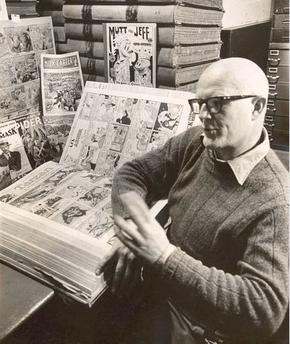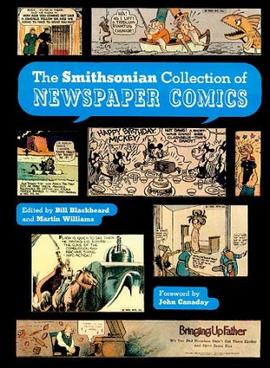Bill Blackbeard facts for kids
Quick facts for kids
Bill Blackbeard
|
|
|---|---|

Bill Blackbeard in 1971
|
|
| Born |
William Elsworth Blackbeard
April 28, 1926 Lawrence, Indiana, U.S.
|
| Died | March 10, 2011 (aged 84) Watsonville, California, U.S.
|
| Nationality | American |
| Education | Fullerton College |
| Occupation | Writer, editor |
| Known for | San Francisco Academy of Comic Art |
|
Notable work
|
The Smithsonian Collection of Newspaper Comics |
| Spouse(s) | Barbara (m. 1966–2011) |
| Awards | Eisner Award, 2004 |
William Elsworth Blackbeard (born April 28, 1926 – died March 10, 2011), known as Bill Blackbeard, was a writer and editor. He started the San Francisco Academy of Comic Art. This academy was a huge collection of comic strips and cartoon art from American newspapers.
His collection included 2.5 million clippings and comic sections. It covered comics from 1894 to 1996. This amazing collection helped Bill Blackbeard and other researchers write many books and articles.
Contents
Bill Blackbeard's Early Life
Bill Blackbeard was born in Lawrence, Indiana. He spent his early years in this small town. When he was about eight or nine, his family moved to Newport Beach, California. There, he went to high school.
During World War II, Bill served in the army. He was part of the 89th Cavalry Reconnaissance Squad. He served in France, Belgium, and Germany. After the war, he went to Fullerton College. He studied history and English. He also worked on the college yearbook, called the Torch.
Bill Blackbeard's Books and Writings
Bill Blackbeard strongly believed that comic strips were important to study. He said, "The comic strip is the only truly American art form." He felt that only people who didn't know much thought comic art was unimportant.
As a writer, Bill worked on over 200 books about cartoons and comic strips. Some of his famous works include 100 Years of Comic Strips and the Krazy & Ignatz series. He also helped with NBM's 18-volume Wash Tubbs and Captain Easy.
A writer named John Adcock said that when Bill Blackbeard started writing about comic strips, many people didn't take them seriously. John explained that Bill thought the best comic strips were as good as great art, movies, and books. Bill spent his life trying to show the world that comics were worth paying attention to.
In 1977, Bill Blackbeard worked with jazz critic Martin Williams. They created The Smithsonian Collection of Newspaper Comics. Many people who study comics see this book as a very important work. It gives a clear look at the most important comic strips of the 20th century.
San Francisco Academy of Comic Art
Bill Blackbeard noticed that libraries were throwing away old newspapers. They did this after putting them on microfilm. So, in 1968, Bill started the San Francisco Academy of Comic Art. It was a non-profit group. He began collecting newspapers from libraries in California. Soon, he collected from libraries all over the country.
Bill and his wife, Barbara, got married in 1966. Their growing collection of newspapers made them move several times in San Francisco. The Academy finally found a long-term home in a Spanish-style house. This house was on Ulloa Street in San Francisco's Sunset district.
A writer named Jeet Heer explained how the collection started. In the early 1960s, Bill realized libraries were getting rid of paper newspapers. They thought the paper would crumble. Bill knew this would make it hard to save the history of comic strips. He asked his local library if he could have the newspapers. They said he couldn't as a private person. But they could donate them to an organization.
So, Bill decided to create his own organization. He became the Founder-Director of the San Francisco Academy of Comic Art in 1968. This allowed him to save as many newspapers as he could. He worked with a group of comic fans. They told libraries across North America to send their old newspapers to the Academy. Two retired bus drivers even helped by driving trucks full of newspapers to Bill.
Over 30 years, Bill collected 75 tons of material. This filled both the upstairs rooms and the garage of his home. In 1997, he had to find a new place for the collection. The homeowner was not renewing his lease.
Bill then talked with Lucy Shelton Caswell. She was in charge of the Billy Ireland Cartoon Library & Museum at Ohio State University. In January 1998, six large trucks moved the entire collection. It went from California to Ohio.
The Billy Ireland Cartoon Library & Museum described Bill's collection. It included clipped comic strips, single comic pages, and whole Sunday comic sections. Bill wanted to collect every comic feature that appeared in American newspapers. He often clipped comics from different newspapers. This was because no single newspaper had every comic. Also, newspapers might stop printing a comic.
Some older comic sections, from the 1890s to the 1920s, were very rare. Bill kept these intact. They had not only comics but also fancy headers and ads. These were all part of the newspaper's original design.
Bill Blackbeard and Double Fold
Bill Blackbeard told writer Nicholson Baker about studies used by libraries. These studies were used to explain why they destroyed many books and newspapers. Baker wrote about this information in his book Double Fold: Libraries and the Assault on Paper (2001). This book won an award. Baker wrote in the book's introduction about his talks with Bill Blackbeard.
Jenny E. Robb, a curator at the Billy Ireland Cartoon Library & Museum, said that in later years, Bill Blackbeard left bound newspaper volumes untouched.
Later Life and Legacy
After selling his collection to Ohio State in 1997, Bill Blackbeard moved. He went from San Francisco to Santa Cruz, California. His wife enjoyed surfing there. He kept writing for books and following his interests. Besides comic strips, he loved pulp magazines, old films, and penny dreadfuls.
Bill Blackbeard passed away on March 10, 2011. He was eighty-four years old. He died in Watsonville, California.
Awards and Recognition
In 2004, Bill Blackbeard received an Eisner Award. This award was for his work on Krazy & Ignatz. This series collected the Sunday pages of the Krazy Kat comic strip. It also included extra information about the artist, George Herriman.
See also
- List of newspaper comic strips


